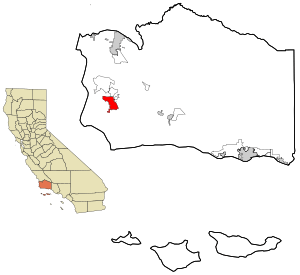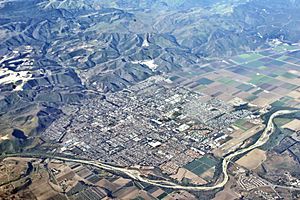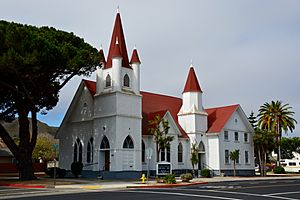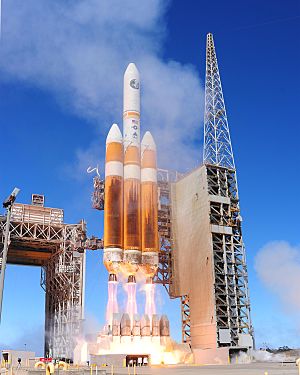Lompoc, California facts for kids
Quick facts for kids
Lompoc
|
|||
|---|---|---|---|
| City of Lompoc | |||
|
Clockwise: Veterans Memorial Building; La Purisima Mission; Jalama Beach; La Purisima Mission; La Purísima Concepción Church.
|
|||
|
|||
| Nickname(s):
"City of Arts and Flowers"
|
|||

Location in Santa Barbara County and the state of California
|
|||
| Country | United States | ||
| State | California | ||
| County | Santa Barbara | ||
| Incorporated | August 13, 1888 | ||
| Named for | Purisimeño:Lum Poc: "Stagnant Water /Lagoon" | ||
| Area | |||
| • Total | 11.70 sq mi (30.31 km2) | ||
| • Land | 11.62 sq mi (30.10 km2) | ||
| • Water | 0.08 sq mi (0.20 km2) 0.66% | ||
| Elevation | 105 ft (32 m) | ||
| Population
(2020)
|
|||
| • Total | 44,444 | ||
| • Density | 3,798.6/sq mi (1,466.31/km2) | ||
| Demonym(s) | Lompocan | ||
| Time zone | UTC-8 (PST) | ||
| • Summer (DST) | UTC-7 (PDT) | ||
| ZIP codes |
93436–93438
|
||
| Area code | 805 | ||
| FIPS code | 06-42524 | ||
| GNIS feature ID | 1652745 | ||
Lompoc ( LOM-pohk; Chumash: Lum Poc) is a city in Santa Barbara County, California. Located on the Central Coast, Lompoc had a population of 44,444 in the 2020 census.
Lompoc has been inhabited for thousands of years by the Chumash people, who called the area Lum Poc, meaning "stagnant waters" or "lagoon" in the local Purisimeño language. The Spanish called the area Lompoco after Fermín de Lasuén had established Mission La Purísima in 1787. In 1837, the Mexican government sold the area as the Rancho Lompoc land grant. Following the American Conquest of California, multiple settlers acquired the Lompoc Valley, including William Welles Hollister, who sold the land around the mission to the Lompoc Valley Land Company, which established a temperance colony which incorporated in 1888 as Lompoc. Lompoc is often considered a military town because it is near Vandenberg Space Force Base.
Contents
History
Prior to the Spanish conquest, the area around Lompoc was inhabited by the Chumash people. La Purisima Mission was established in 1787 near what is now the southern edge of the city. Purisimeño, a Chumashan language, was spoken in the region during the mission period. After an earthquake destroyed the mission in 1812, it was relocated to its present location 1 mile (1.6 km) northeast of the present city. After independence from the Spanish Empire, the First Mexican Empire was established in 1821. The Mexicans secularized the Spanish missions in 1833, and La Purisima Mission gradually fell into ruins.
The coastal branch of the Southern Pacific Railroad replaced ship transportation around 1900. In 1893, a diatomaceous earth mine opened in the southern hills in Miguelito Canyon. It became (and still is) the largest marine diatomite mine in the world, and at one time was the largest employer in the valley. In the 1940s, Grefco, another diatomaceous earth company, moved to Lompoc. It ceased operations in 1998, but the remnants of its mine can still be seen at the northeast end of town. In 1909, the Sibyl Marston—at the time, the largest steam schooner built on the West Coast—sank nearby while carrying 1,100,000 board feet (2,600 m3) of lumber. Many of the older Lompoc homes were built with lumber from the shipwreck. The wreckage can still be seen south of Surf Beach.
A paved road linked Lompoc to Buellton and the rest of California around 1920. In 1923, the Honda Point disaster, the U.S.'s largest peacetime naval accident, occurred just off the coast; nine U.S. destroyers ran aground, killing 23 people. During the Great Depression, La Purisima Mission was restored by the Civilian Conservation Corps (CCC). During World War II, the coast west of Lompoc was the site of Camp Cooke, a United States Army training camp where large units could practice maneuvers.
Lompoc grew slowly until 1958, when the United States Air Force announced that the former Camp Cooke would be a test site for the Thor family of intermediate-range ballistic missiles and the first operational base for the SM-65 Atlas, an intercontinental ballistic missile. The city then began to grow rapidly to provide housing for thousands of civilians and contractors employed at what was soon renamed Vandenberg Air Force Base. It was the first missile base of the United States Air Force.
The Space Shuttle program was slated to begin launches in the late 1980s, and the city experienced a boom in restaurant and hotel construction in anticipation of tourists coming to see shuttle launches. However, when the Challenger exploded during take-off from Cape Canaveral in 1986, the West Coast shuttle program was terminated, sending Lompoc into a severe recession.
Today, Lompoc is called "The City of Arts and Flowers" and is also becoming known for its wines.
Geography

Lompoc is located at 34°38′46″N 120°27′37″W / 34.64611°N 120.46028°W (34.646182, -120.460316). According to the United States Census Bureau, the city has a total area of 11.7 square miles (30 km2), 99.34% of it land and 0.66% of it water.
Most of the city is in the valley of the Santa Ynez River, at an elevation of about 80–100 feet (25–30 meters); recent expansion has been to the north, on higher ground known as Vandenberg Village, with elevations of 150–300 feet (50–100 meters). Like most rivers in Southern California, the Santa Ynez River does not have a surface flow for most of the year. Underground flow in the sandy river bed recharges the aquifer beneath the city, from which nine wells (with a tenth one planned) supply the city with water. Unlike many other cities in Southern California, Lompoc is not connected to the State Water Project.
Climate
Lompoc has a cool Mediterranean climate (Köppen climate classification Csb), typical of coastal California. The city is mostly sunny, with an ocean breeze. Fog is common. Snow is virtually unknown. The highest recorded temperature was 110 °F (44 °C) in 1987, and the lowest recorded temperature was 15 °F (-9 °C) in 2013.
| Climate data for Lompoc, California | |||||||||||||
|---|---|---|---|---|---|---|---|---|---|---|---|---|---|
| Month | Jan | Feb | Mar | Apr | May | Jun | Jul | Aug | Sep | Oct | Nov | Dec | Year |
| Average high °F (°C) | 64 (18) |
64 (18) |
66 (19) |
67 (19) |
68 (20) |
70 (21) |
72 (22) |
73 (23) |
74 (23) |
73 (23) |
68 (20) |
63 (17) |
68.5 (20.3) |
| Average low °F (°C) | 42 (6) |
44 (7) |
46 (8) |
47 (8) |
50 (10) |
53 (12) |
56 (13) |
56 (13) |
55 (13) |
51 (11) |
46 (8) |
42 (6) |
49 (9) |
| Average rainfall inches (mm) | 3.33 (85) |
3.71 (94) |
2.88 (73) |
1.01 (26) |
0.29 (7.4) |
0.04 (1.0) |
0.01 (0.25) |
0.03 (0.76) |
0.1 (2.5) |
0.74 (19) |
1.41 (36) |
2.56 (65) |
16.11 (409) |
| Source: Weather Channel | |||||||||||||
Demographics
| Historical population | |||
|---|---|---|---|
| Census | Pop. | %± | |
| 1880 | 226 | — | |
| 1890 | 1,015 | 349.1% | |
| 1900 | 972 | −4.2% | |
| 1910 | 1,482 | 52.5% | |
| 1920 | 1,876 | 26.6% | |
| 1930 | 2,845 | 51.7% | |
| 1940 | 3,379 | 18.8% | |
| 1950 | 5,520 | 63.4% | |
| 1960 | 14,415 | 161.1% | |
| 1970 | 25,284 | 75.4% | |
| 1980 | 26,267 | 3.9% | |
| 1990 | 37,649 | 43.3% | |
| 2000 | 41,103 | 9.2% | |
| 2010 | 42,434 | 3.2% | |
| 2020 | 44,444 | 4.7% | |
| U.S. Decennial Census | |||
2010

In the 2010 United States Census, Lompoc had a population of 42,434. The population density was 3,634.7 people per square mile (1,403.4/km2). The racial makeup was 25,950 (61.2%) White; 2,432 (5.7%) African American; 750 (1.8%) Native American; 1,615 (3.8%) Asian; 186 (0.4%) Pacific Islander; 9,020 (21.3%) from other races; and 2,481 (5.8%) from two or more races. There were 21,557 Hispanics or Latinos of any race (50.8%).
The Census reported that 38,778 people (91.4% of the population) lived in households, 99 (0.2%) lived in non-institutionalized group quarters, and 3,557 (8.4%) were institutionalized.
There were 13,355 households, of which 5,481 (41.0%) had children under the age of 18 living in them; 6,323 (47.3%) were opposite-sex married couples living together; 2,061 (15.4%) had a female householder with no husband present; and 913 (6.8%) had a male householder with no wife present. There were 949 (7.1%) unmarried opposite-sex partnerships and 75 (0.6%) same-sex married couples or partnerships. 3,304 households (24.7%) were made up of individuals, and 1,187 (8.9%) had someone living alone who was 65 years of age or older. The average household size was 2.9. There were 9,297 families (69.6% of all households); the average family size was 3.48.
The population included 11,188 people (26.4%) under the age of 18, 4,452 people (10.5%) aged 18 to 24, 12,233 people (28.8%) aged 25 to 44, 10,338 people (24.4%) aged 45 to 64, and 4,223 people (10.0%) who were 65 or older. The median age was 33.9 years. For every 100 females, there were 114.9 males. For every 100 females age 18 and over, there were 118.7 males.
There were 14,416 housing units at an average density of 1,234.8 per square mile (476.8/km2), of which 6,493 (48.6%) were owner-occupied and 6,862 (51.4%) were occupied by renters. The homeowner vacancy rate was 2.2%; the rental vacancy rate was 7.1%. 18,534 people (43.7% of the population) lived in owner-occupied housing units, and 20,244 people (47.7%) lived in rental housing units.
2000
As of the 2000 Census, there were 43,284 people, 13,059 households and 9,311 families residing in Lompoc. The population density was 3,532.2 people per square mile (1,363.4/km2). There were 13,621 housing units at an average density of 1,170.5 per square mile (451.8/km2). The racial makeup of the city was 65.81% White, 7.34% African American, 1.58% Native American, 3.90% Asian, 0.32% Pacific Islander, 15.68% from other races, and 5.35% from two or more races. Hispanics or Latinos of any race were 37.31% of the population.
There were 13,059 households, of which 41.1% had children under the age of 18 living with them, 51.0% were married couples living together, 14.8% had a female householder with no husband present, and 28.7% were non-families. 23.5% of all households were made up of individuals, and 8.3% had someone living alone who was 65 or older. The average household size was 2.88, and the average family size was 3.42.
The population included 29.9% under the age of 18, 8.9% from 18 to 24, 33.3% from 25 to 44, 18.5% from 45 to 64, and 9.4% who were 65 or older. The median age was 32. For every 100 females, there were 113.0 males. For every 100 females age 18 and over, there were 116.4 males.
The median income for a household in the city was $47,587, and the median income for a family was $62,199. Males had a median income of $35,074, versus $26,824 for females. The per capita income was $15,509. About 12.6% of families and 15.4% of the population were below the poverty line, including 20.8% of those under 18 and 6.7% of those 65 or older.
Transportation
State Route 1 is the major north–south artery through Lompoc. State Route 246 heads east to Buellton and the Santa Ynez Valley.
The Surf train station is located to the west at Surf Beach and is served by Amtrak's Pacific Surfliner line. Thruway Motorcoach buses stop in town. Lompoc is also served by City of Lompoc Transit, the Clean Air Express to Santa Barbara/Goleta, and the Breeze Bus to Buellton/Solvang and Santa Maria.
Culture
The Lompoc Valley Flower Festival, held the last week of June, features a parade, carnival and craft show. In 2002, the Bodger Seed Company planted a "floral flag" as a tribute after the September 11 attacks. The "flag" was 740 feet by 390 feet, covered 6.65 acres, and was estimated to contain more than 400,000 larkspur plants.
The Lompoc arts scene features a number of musicians and bands, ranging from singer-songwriters to psychedelic blues-rock bands. At the center of this scene is Howlin’ Byroon’s Music Exchange, a music store and frequent venue for Lompoc’s musicians. The shop opened in May 2009 and offers guitar lessons, consigned musical instruments and live performances.
Local artists
One of Lompoc’s most successful musical artists is the rock band Saint Anne’s Place, which was formed in 2008 and originally featured Jacob Cole, Samuel Cole, JT Wild and Clive Hacker. Today, its members are the Coles and their cousin, Joel, a bassist. They grew up playing in their families' blues bands and released their first EP, Speak Easy, in 2011. The band’s music has been described as a "blistering yet rustic mix of blues, psychedelia, and folk rock with the chops of players twice their senior". In 2011, they won the Santa Barbara Independent battle of the bands. They released their second EP, The Earth Shaker, in December 2012 to positive reviews by the local media.
Emily Wryn is a Lompoc songwriter whose music has been featured on NPR’s Morning Becomes Eclectic. Her first EP, Head on Straight, was released in February 2012, and she played at the Indie Week festival in Ireland in April 2014. Wryn also collaborates with a local band, Saint Anne’s Place, in a group called The Lights Electric.
Another band, Millions, led by Randall Sena, plays along the Central Coast. Sena recorded and produced Wryn’s Head on Straight and Saint Anne’s Place’s Speak Easy in his recording studio, Certain Sparks.
Lompoc Theatre
The Lompoc Theatre, which opened in 1927, was owned and operated by the Calvert family for many years. It encountered financial trouble in the 1970s because of competition from multiplexes and television. The last time a movie was shown on its screen was in 1985.
In July 2003, a non-profit group, the Lompoc Housing and Community Development Corporation, announced plans to restore the theater. With the assistance of the city, the LHCDC was able to raise funds to buy the theater. By March 2008, the cost of renovating the building was estimated at just under $10 million. The LHCDC was unable to raise the money needed for renovations, and the building accumulated three liens. It was eventually sold to a grassroots group called the Lompoc Theatre Project, which hopes to reopen the theatre in 2017.
Lompoc Pops Orchestra
The Lompoc Pops Orchestra has been performing for 20 years. Composed of approximately 45 semi-professional musicians, under the direction of Dr. Brian Asher Alhadeff, its four annual performances include musicals, Broadway hits, jazz pieces, big band, gospel and patriotic music.
In popular culture
- In the late 1960s, Quaker Oats had a marketing campaign that pitted two of its cereal mascots, Quisp and Quake, against each other in a race from Long Island to Lompoc.
- The 1960s animated cartoon series Roger Ramjet, whose creators hailed from Lompoc, had many references to the city, which was the titular character's hometown.
- The W.C. Fields movie The Bank Dick is set in Lompoc, although the city's name is mispronounced "Lom-pock".
- The Travel Channel's Ghost Adventures filmed at La Purisima Mission to investigate claims of hauntings.
- The movie Sideways was filmed in Lompoc and the Santa Ynez Valley east of town.
- In the video game Grand Theft Auto IV, it is on Lompoc Avenue that Roman Bellic is held hostage by the Russian mafia in an abandoned warehouse.
- In the 1990s television show Northern Exposure, DJ Chris Stevens sends his best wishes to a friend locked up in Lompoc.
- Referenced in the 1989 movie Tango & Cash.
- In the 1998 movie Out of Sight, starring George Clooney and Jennifer Lopez, Clooney's character was imprisoned at Lompoc.
- The 1970s game show Hollywood Squares once featured the question: "Lompoc: fatal cattle disease or small California town?" The contestant answered correctly.
- In Season 3, Episode 1 of The Closer, a few of the characters live and work in Lompoc. In one scene, a Lompoc cop comments that they rarely see any "action" in that city.
- In the movie A Haunted House, Cedric the Entertainer's character mentions that he was incarcerated in the Lompoc Penitentiary.
- In the song "Yay Area", rapper E-40 mentions that he has friends "in Lompoc and Skeleton Bay", a reference to the prison.
- In The Fast and The Furious (2001), Toretto says he spent "two years in Lompoc. I'll die before I go back." Later in the series, in Fast & Furious (2009), Toretto is sentenced to 25 years to life at the Lompoc prison.
- In Season 3, Episode 5 of The Fresh Prince of Bel-Air, Carlton says he's driving to Lompoc to elope. Will tells him no one drives to Lompoc; they drive through Lompoc.
- In Season 2, Episode 16 of the TV show Monk, Monk claims to have been in the Lompoc prison before being moved to another.
Sister cities
Lompoc has five sister cities:
 Cheyenne, Wyoming
Cheyenne, Wyoming Inca, Spain
Inca, Spain Lake Placid, Florida
Lake Placid, Florida Locarno, Switzerland
Locarno, Switzerland Namwon, Republic of Korea (South Korea)
Namwon, Republic of Korea (South Korea)
Tourist attractions
Economy
Vandenberg Space Force Base dominates the economy, directly employing more Lompoc residents than any other employer, and contributing $1.7 billion to the regional economy. Other mainstays of the economy include the Federal Correctional Institution, the diatomaceous earth mine (today owned by Imerys), the Lompoc Oil Field and associated oil processing facilities north of town, and agriculture (especially seed flowers and vegetables).
Wine production and wine tourism make up an expanding agricultural sector. Lompoc Valley is the gateway to the Sta. Rita Hills AVA wine appellation, internationally recognized for premium pinot noir and chardonnay. Thirty premium boutique wine labels are produced in Lompoc. Numerous other wineries are located along State Route 246 and on Santa Rosa Road. Tasting rooms are located in various parts of Lompoc.
Since the end of the Cold War, many workers employed in Santa Barbara and Goleta have moved to Lompoc to take advantage of lower housing costs, effectively making Lompoc a bedroom community of Santa Barbara. The character of the town has changed considerably with the growth associated with this demographic shift. In addition, new housing developments are spreading into the adjacent hills on the north side of town.
Education
Lompoc is served by the Lompoc Unified School District.
The two high schools in the area are Cabrillo High School and Lompoc High School.
Notable people
- Julian Araujo, professional soccer player (LA Galaxy)
- Jeff Bettendorf, professional baseball player (Oakland Athletics)
- Mike Bratz, former professional basketball player (San Antonio Spurs, Cleveland Cavaliers, Chicago Bulls, Golden State Warriors, Sacramento Kings, Phoenix Suns)
- Casey Candaele, former professional baseball player (Montreal Expos, Houston Astros, and Cleveland Indians)
- Ryan Church, former professional baseball player (Washington Nationals, New York Mets, Atlanta Braves, Pittsburgh Pirates, and Arizona Diamondbacks)
- Jeffrey Combs, actor, raised in Lompoc
- Danny Duffy, professional baseball player (Kansas City Royals)
- Jacqueline Gadsden, 1920s film actress, born in Lompoc
- Brian Givens, former professional baseball player (Milwaukee Brewers)
- Johnnie Gray, former professional football player (Green Bay Packers)
- Mark Herrier, actor, graduated from Lompoc High School
- Winifred Hervey, executive producer and writer, The Fresh Prince of Bel-Air and The Steve Harvey Show
- Roy Howell, former professional baseball player (Texas Rangers, Toronto Blue Jays, and Milwaukee Brewers)
- Bill Howerton, former professional baseball player (St. Louis Cardinals, Pittsburgh Pirates, and New York Giants)
- Napoleon Kaufman, former professional football player (Oakland Raiders)
- Gabe Lopez, singer/songwriter
- Jonathan Majors, actor, born in Lompoc
- John D. Nesbitt, western writer and American literature and language educator living in Wyoming.
- George Perry, Alzheimer's disease researcher and dean and professor of biology at the University of Texas at San Antonio
- Duane Solomon, 800m Olympian
- Roy Thomas, former professional baseball player (Seattle Mariners)
- Tommy Thompson, former professional football player (San Francisco 49ers)
- Dorien Wilson, actor, The Parkers and Dream On
Images for kids
-
Mission La Purísima was founded in 1787 by the Spanish, under the leadership of Fermín de Lasuén.
-
Lompoc Veterans Memorial Building, built in a Spanish Colonial Revival style in 1936, is a National Historic Landmark.
See also
 In Spanish: Lompoc para niños
In Spanish: Lompoc para niños















